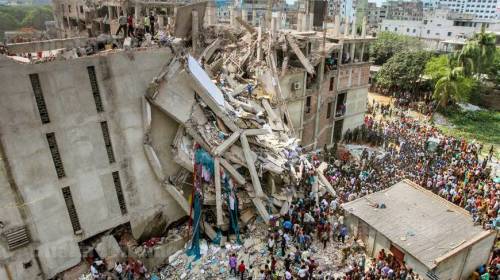by VINAY LAL
 Rana Plaza Building Collapse, Dhaka, Bangladesh
Rana Plaza Building Collapse, Dhaka, Bangladesh
Jeremy Seabrook, an independent writer, journalist, and chronicler of the human condition who has long had an interest in South Asia, probing especially the lives of those who inhabit India’s slums and Muslim ghettos, turns his attention in his most recent book to the workers of Bangladesh’s garment industries who clothe the world but, like the weavers of Bengal in colonial India, barely have enough to cover their own nakedness. The book takes its title from Thomas Hood’s elegy on the women workers in Lancashire’s textile mills, “The Song of the Shirt” (1843): working “in poverty, hunger, and dirt,” moving their fingers to the command of “Stich! Stich! Stich!”, they sowed at once, “with a double thread, A Shroud as well as a Shirt.”
If Bangladesh has emerged at all in the news in recent years, it is on account of the disasters that have befallen its garment industry, none as calamitous as the collapse of the Rana Plaza commercial building under whose debris over 1,100 people were left dead. Seabrook’s book is a searing indictment of the callousness of factory owners and others in the global system of the circulation of capital who are complicit in creating miserable working conditions for those employed in Bangladesh’s largest and most profitable industrial venture. Yet it is also an extraordinary tribute to the workers who pile into Dhaka and other centers of the garment industry from all corners of the country. Their lives are sketched not so much in detail as in poignantly suggestive prose. Do people flee to that “washed out concrete jungle” that is called Dhaka, which Seabrook unflinchingly describes as one of the world’s ugliest cities, to escape the narrowing of human possibilities that Marx sought to capture in his brutal condemnation of the “idiocy of the rural countryside”? One might suppose that it is the aspiration to become something in life, or merely to earn a livelihood, that brings people to the city from the interior, but what would then make the story of Bangladesh so distinct?
Lal Salaam for more
